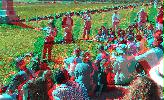Finally we head to
the last site of our journey,
where a park ranger provides a
thrilling narrative of what took place at this site.
Briefly, this is the site where
the Battle of Gettysburg ended. After two days where General Lee was
unable to break the Union defenses he
ordered a direct assault against
the center of the Union lines. The task was to be carried out by Gen.
Longstreet, who considered the move
a big mistake. Nonetheless
the Confederates, 12,500-strong formed a mile-wide line and marched toward the
U.S. forces in an open field.
Through a series of bad timing,
unclear orders, and strong Union gunfire the attack was underway. Due
to heavy cannon fire smoke the Confederates
couldn't see that the Union
forces were MUCH greater in numbers than believed. As the Confederates got
within a few hundred yards from the stone
wall seen here, Union troops
opened fire unleashing the deadliest response in all the war. Instead of
solely relying on musket rifles, cannons loaded with
canisters containing rocks, broken glass, metal fragments
and more were fired at the incoming troops, cutting huge gaps in their
lines. Carnage and
death reined supreme! Some
Confederates breached the
wall, but they were immediately dispensed with.
In less than one hour the
assault, known as Pickett's Charge sputtered to a halt. Realizing the
gravity of his mistake, under an informal truce, Lee
gathered up his battered army
and fled back to Virginia. Exhausted, the Union command didn't bother to
pursue. The Confederates' deepest penetration
into the North became known as
their "high water mark," and from that point the Southern rebellion would
continue to deteriorate until the
war's end in April,
1865.
Sadly, one of the last
casualties of the war was Abraham Lincoln, who was felled by an assassin's
bullet, just days after Gen. Lee surrendered
to Union general Ulysses Grant
at Appomattox Court House, Virginia.
Marshall
